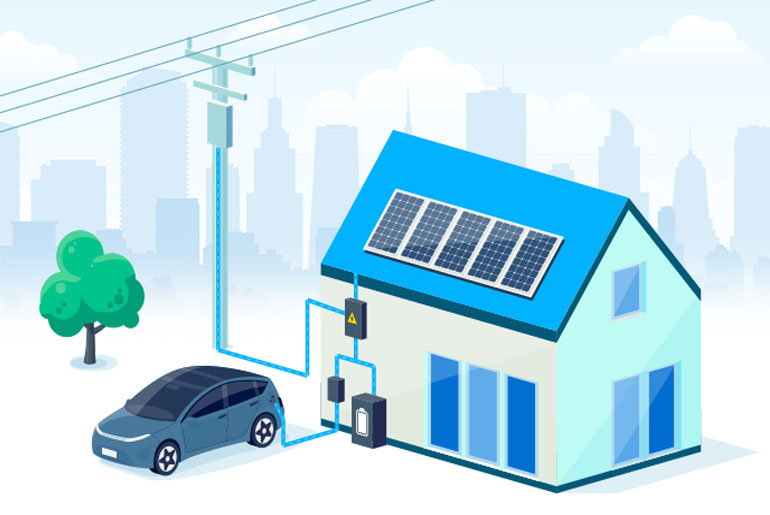As the world pivots towards a more sustainable future, electric vehicles (EVs) have emerged as a pivotal element in reducing greenhouse gas emissions and reliance on fossil fuels. Among the numerous technological advancements in the EV sector, bi-directional charging stands out as a transformative innovation. This technology, which enables electric vehicles to not only draw power from the grid but also send it back, promises to revolutionize how we use, manage, and interact with energy systems.
Understanding Bi-Directional Charging
Bi-directional charging, also known as Vehicle-to-Grid (V2G) technology, allows energy to flow both into and out of an EV’s battery. Traditional charging methods are unidirectional, where electricity flows from the grid to the vehicle. In contrast, bi-directional charging enables the vehicle to act as a mobile energy storage unit, capable of returning power to the grid, a home, or other electric devices.
Key Components of Bi-Directional Charging
- Onboard Charger: The EV must be equipped with an onboard charger capable of handling two-way power flow.
- Smart Inverter: This device converts direct current (DC) from the battery to alternating current (AC) for use in homes or the grid, and vice versa.
- Communication Systems: Advanced communication protocols ensure seamless interaction between the EV, the grid, and other connected systems, enabling efficient energy management.
Benefits of Bi-Directional Charging
- Grid Stabilization: One of the most significant advantages of bi-directional charging is its potential to stabilize the power grid. During periods of high electricity demand, EVs can supply power back to the grid, reducing the need for additional power plants and enhancing grid reliability.
- Renewable Energy Integration: Bi-directional charging supports the integration of renewable energy sources like solar and wind. EVs can store excess renewable energy generated during peak production times and return it to the grid when production is low, thereby smoothing out the variability inherent in renewable energy generation.
- Cost Savings: For consumers, bi-directional charging offers economic benefits. During peak electricity demand periods, when energy prices are higher, EV owners can sell electricity back to the grid at a premium. Conversely, they can charge their vehicles during off-peak hours when electricity is cheaper.
- Emergency Power Supply: EVs with bi-directional charging can serve as emergency power sources during outages. By providing electricity to homes or essential devices, these vehicles can enhance resilience and safety during power interruptions.
- Environmental Impact: By optimizing the use of renewable energy and reducing reliance on fossil fuel-based power plants, bi-directional charging can contribute to significant reductions in greenhouse gas emissions.
Challenges to Adoption
- Infrastructure Requirements: Implementing bi-directional charging requires significant upgrades to existing power infrastructure, including smart grids and advanced metering systems. These upgrades entail considerable investment and coordination among utilities, governments, and consumers.
- Battery Degradation: Frequent charging and discharging cycles can accelerate battery wear and reduce its lifespan. Advances in battery technology and management systems are necessary to mitigate these effects and ensure long-term viability.
- Regulatory and Standardization Issues: Widespread adoption of bi-directional charging depends on the establishment of uniform standards and regulatory frameworks. These standards must address technical compatibility, safety, and grid integration requirements.
- Consumer Awareness and Acceptance: Educating consumers about the benefits and potential of bi-directional charging is crucial for its adoption. Additionally, incentives and policies that encourage participation will play a significant role in driving uptake.
Future Prospects and Innovations
The future of bi-directional charging looks promising, with several technological advancements and pilot projects paving the way for broader adoption.
- Advanced Battery Technologies: Research and development in battery chemistry and design aim to enhance energy density, reduce degradation, and improve efficiency. Solid-state batteries, for example, offer potential improvements in longevity and performance, making bi-directional charging more practical.
- Smart Grid Integration: As smart grids become more widespread, they will facilitate better management and integration of bi-directional charging. Smart grids enable real-time communication and energy management, optimizing the flow of electricity between EVs and the grid.
- Pilot Projects and Real-World Applications: Numerous pilot projects worldwide are demonstrating the feasibility and benefits of bi-directional charging. For instance, projects in Denmark, the UK, and the US are exploring V2G technology’s impact on grid stability and renewable energy integration.
- Vehicle-to-Home (V2H) and Vehicle-to-Anything (V2X): Expanding beyond V2G, bi-directional charging technology can also enable Vehicle-to-Home (V2H) and Vehicle-to-Anything (V2X) applications. V2H allows EVs to power homes, reducing reliance on the grid, while V2X encompasses a broader range of applications, including powering other vehicles or even providing energy to remote or off-grid locations.
Conclusion
Bi-directional charging represents a paradigm shift in how we perceive and utilize electric vehicles. By transforming EVs into mobile energy assets, this technology offers a myriad of benefits, from grid stabilization and renewable energy integration to cost savings and emergency power supply. While challenges remain, ongoing advancements in technology, infrastructure, and regulatory frameworks are paving the way for a future where bi-directional charging is a standard feature of electric mobility. As we continue to innovate and invest in this transformative technology, the vision of a sustainable, efficient, and resilient energy ecosystem comes ever closer to reality.

